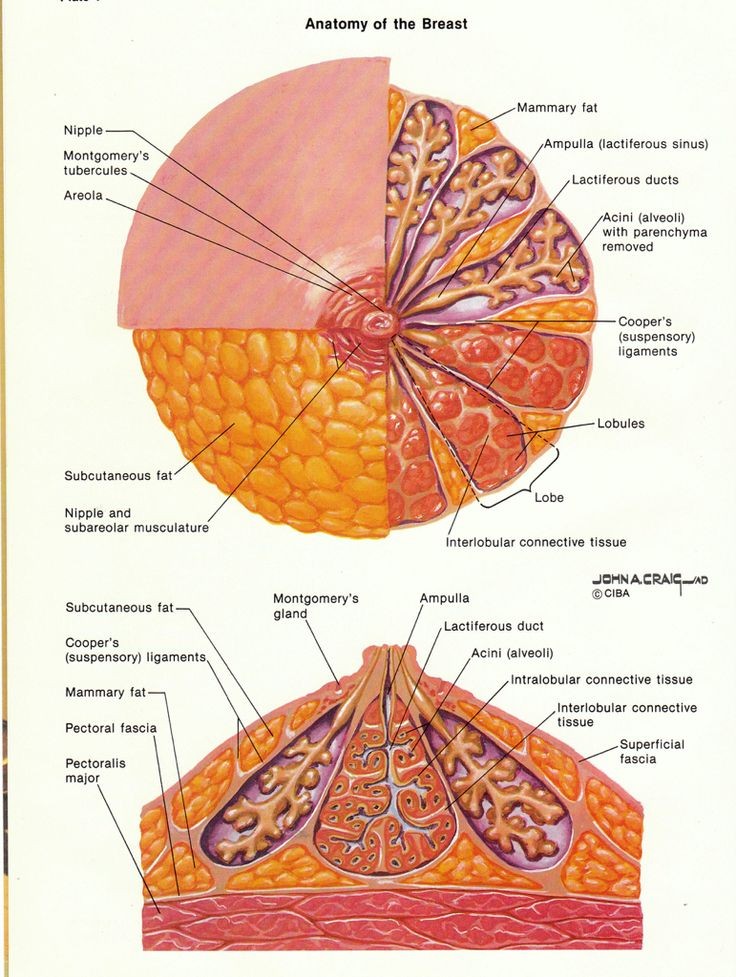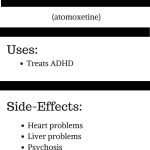
Contents
Breast Anatomy
The breasts, located on the front of the chest, are medically known as the mammary glands. The term "breast" is sometimes used to refer to the area at the front of the chest. Both males and females have breasts.
Anatomical Features of the Breast
The mammary gland is made up of lobules — glandular structures that produce milk in females when stimulated. The lobules drain into a system of ducts that transport the milk to the nipple. The breast also contains fat and connective tissue.
In females, milk exits the breast at the nipple, which is surrounded by a darkened area of skin called the areola. The areola contains modified sweat glands known as Montgomery’s tubercules. These glands secrete fluid to lubricate the nipple during breastfeeding.
The breast does not contain muscles. Breast tissue is located on top of the chest wall muscles. Blood and lymphatic vessels are located throughout the breast. The lymphatic vessels in the breast drain to the lymph nodes in the underarm area (axilla) and behind the breast bone (sternum).
The anatomical features of the breast include:
- Nipple: A raised structure located in the center of the breast. It contains small muscles that contract in response to stimulation.
- Areola: The darker pigmented area surrounding the nipple. It contains sebaceous glands that secrete an oily substance to protect the nipple during breastfeeding.
- Lobes: The breast is made up of 15-20 lobes, which are divided into smaller lobules. Each lobule contains milk-producing glands called alveoli.
- Ducts: The alveoli are connected to a network of ducts that transport milk to the nipple during breastfeeding.
- Fat and connective tissue: The breast also contains a significant amount of fat and connective tissue, which give it its shape and support.
- Lymph nodes: The breast has lymph nodes located in the axilla (armpit), which play an important role in the immune system.
The size and shape of the breast can vary greatly among individuals, depending on factors such as age, genetics, and hormonal changes.
Differences in Human Breasts Compared to Other Species
In other primates, the breasts develop only when producing milk. After weaning, the breasts flatten again. In humans, the breasts enlarge at puberty and stay enlarged throughout a woman’s life.
Development of Breast Tissue
Picture of the milk lines
Breast tissue begins to form in the fourth week of fetal life. Breast tissue develops along two "milk lines" that start at the armpit and extend to the groin. Occasionally, an extra breast can develop along this line, along with an extra nipple.
As the ducts grow, they are surrounded by fatty and connective tissue, which give the breast its shape and structure. The lobes and lobules, responsible for producing milk during breastfeeding, also begin to develop at this time.
Breast development typically continues until the age of 18-19, although it can continue into the early twenties. The size and shape of the breasts can vary greatly among individuals, depending on factors such as genetics, hormonal changes, and body weight.
The breast tissue can continue to change throughout a woman’s life, particularly during pregnancy and menopause. Hormonal changes during these times can cause the breast tissue to expand and contract, leading to changes in breast size and shape.
QUESTION
Common Medical Conditions Affecting the Breasts
Breast health is a concern for many women. Breast cancer is a common malignancy affecting one in eight women in the U.S. at some point in life, but benign conditions of the breast are much more common. Most breast masses and lumps are not cancer. Breast cancer also occurs in males, but it accounts for a small percentage of cases.
Among the benign breast conditions, cysts and fibrocystic changes are common. A type of benign tumor known as fibroadenoma is also common in young women. Infections of the breast tissue can occur, particularly during breastfeeding. Mastitis is the term used to describe inflammation or infection of the breast.
The most common medical conditions affecting breasts include:
- Fibrocystic breast changes: A benign condition in which the breast tissue feels lumpy and/or rope-like. It is most commonly seen in women of reproductive age and can cause breast pain and tenderness.
- Fibroadenomas: Benign breast tumors that can feel like a smooth, firm lump in the breast tissue. They are most commonly seen in women under 30.
- Breast infections: Infections of the breast tissue, such as mastitis or abscesses, can cause pain, swelling, and redness in the breast.
- Breast cancer: A malignant tumor that forms in the breast tissue. It can present as a lump, thickening, or dimpling in the breast tissue. While breast cancer can occur in both men and women, it is much more common in women.
- Breast cysts: Fluid-filled sacs that can form in the breast tissue. They are typically benign and may cause pain or discomfort.
- Nipple discharge: Discharge from the nipple can be a sign of an underlying medical condition, such as infection, injury, or benign or malignant growth.
Changes in the Breasts During Pregnancy
During pregnancy, the breasts grow further due to stimulation by estrogen. The growth during pregnancy is more uniform than that observed at puberty. The amount of tissue capable of producing milk is approximately the same in all women, so women with smaller breasts produce the same amount of milk as women with larger breasts.
Some changes that occur in the breasts during pregnancy include:
- Breast growth: The breasts may increase in size and feel heavy or tender due to the growth of the milk-producing glands and ducts.
- Darkening of the nipples and areolas: The skin around the nipples may darken and the nipples themselves may become more prominent.
- Vein enlargement: The veins in the breast may become more visible and enlarged.
- Colostrum production: During the later stages of pregnancy, the breasts may begin to produce colostrum, a nutrient-rich fluid that is the first milk produced by the breast.
- Stretch marks: The breast skin may stretch and develop stretch marks as the breast tissue expands.
After childbirth, the breasts will continue to change as the mother begins to produce milk. As the baby begins to breastfeed, milk production and breastfeeding can help the uterus contract and return to its pre-pregnancy size.
Most Common Breast Lump
The most common breast lump is a benign fibroadenoma.
- Fibroadenomas are more commonly found in younger women and are typically smooth, firm, and round or oval-shaped.
- They can range in size from a few millimeters to several centimeters and are often painless.
- Fibroadenomas can be felt as a distinct lump in the breast tissue and can be confirmed through imaging tests, such as mammography or ultrasound.
- While fibroadenomas are usually benign, it is important to have any breast lump evaluated by a healthcare provider to rule out the possibility of breast cancer.
Subscribe to MedicineNet’s Cancer Report Newsletter
By clicking "Submit," I agree to the MedicineNet Terms and Conditions and Privacy Policy. I also agree to receive emails from MedicineNet and I understand that I may opt out of MedicineNet subscriptions at any time.
By clicking "Submit," I agree to the MedicineNet Terms and Conditions and Privacy Policy. I also agree to receive emails from MedicineNet and I understand that I may opt out of MedicineNet subscriptions at any time.


